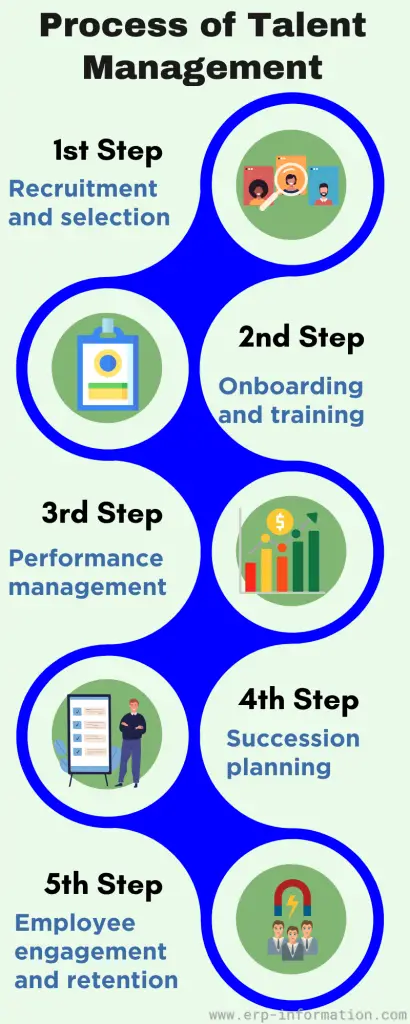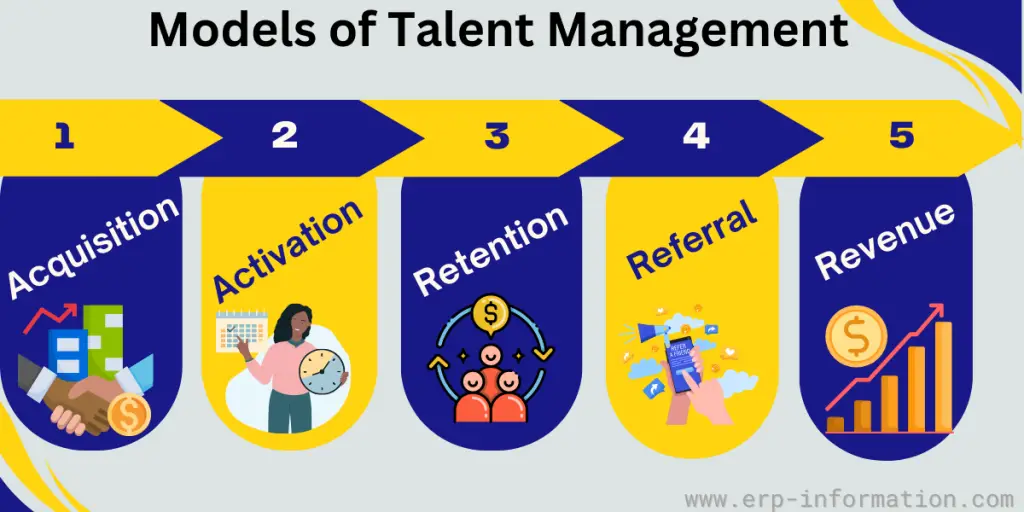Throughout the years, talent management techniques have developed and adapted to people-specific trends, much like other areas in the workplace, and have rapidly evolved in recent decades.
In today’s hyper-changing, globalized world, talent management has become imperative. Global changes in talent and human resources management are causing a workplace resurgence.
When was your employer last asked if you were satisfied and equipped with the skills you need to flourish? These questions are commonplace at a company with an effective talent management program.
We have constructed this blog post to provide you with complete knowledge about talent management, including its process, strategy, models, and challenges.
What is Talent Management?
Talent management is an investment in the organization’s human resources to get efficient work done. It is a strategic process of attracting, developing, retaining, and promoting talented employees.
It involves identifying key individuals within the organization who have the potential to make significant contributions to the company’s success and then providing them with the resources, training, and support they need to maximize their potential.
Talent management goals
Talent management aims to create a high-performance culture within the organization by nurturing and developing top talent. This requires a comprehensive approach that includes talent management activities.
Process of Talent Management
Recruitment and selection
The first process is to identify and attract qualified candidates with the right skills, experience, and cultural fit.
Onboarding and training
Providing new hires with the resources and tools to succeed, offering ongoing training, and providing development opportunities to help employees grow.
Performance management
Setting clear expectations, providing ongoing feedback and coaching, and assessing performance regularly to identify areas for improvement and provide recognition and rewards for top performers.
Succession planning
Preparing for the future by identifying potential leaders and developing plans to ensure a smooth transition when key positions become vacant.
Employee engagement and retention
Creating a positive work environment that encourages employee engagement, satisfaction, and loyalty and implementing programs and policies to retain top talent.
You can check your Employee utilization rate using our calculator
Importance of Talent Management
The benefits of the successful hiring strategy include increased employee involvement, better retention, and improved employee satisfaction – the result is better employer branding.
Talent managers should look at long-range sustainability rather than focusing on the present position.
Attracts and motivates new talents
Human Resources (HR) uses strategies to determine the skills and qualities needed for new hires. Talent management makes it easier and faster to find people for new jobs.
When employees feel appreciated, they will eventually talk well about their job. This can help a company build a good reputation and attract more open positions.
Makes business work better
A company with the right employees in the right jobs can do well. That means the company can get more work done and be better than other companies.
To do this, companies need to hire great people and help them to give their best performance. This gives them an edge over other businesses.
Makes systematic planning and management
It helps find and prepare the best employees to take over important roles in the future. This way, when someone leaves their job, another person is ready to take their place and role quickly, and the business can keep running smoothly without interruptions.
Increases productivity
Talent management helps to increase productivity by creating a good work environment. This will help people be happier, more productive, and work better.
HR professionals must ensure that talent management efforts are a priority and they align with the company’s goals and values.
Encourages innovations
Companies want their employees to improve and think of new ideas. This helps the business keep up with other companies and improve products and services.
Helps to retain employees
Finding and training new people costs a lot of money when good employees leave. In order to retain their valuable workers, companies must ensure their employees are happy, appreciated, and have opportunities to grow.
Talent management will help them stay longer and reduce the number of people who leave.
Encourages employees to learn new skills
Talent management is about helping employees learn new skills. This can happen through training, mentoring, and coaching.
When employers invest in their employees, it helps them improve at their jobs and advance in their careers. This also helps the employer fill positions that need certain skills and keep those employees with those skills from leaving the company.
Models of Talent Management
Refer below image for a better understanding of basic models.
Talent management models help plan and optimize successful talent management plans and their elements to maximize performance and effectiveness. AARRR (acquisition, activation, retention, referral, and revenue) or Pirate Metric Model has largely used frameworks that outline different phases in a client’s journey.
This can also be applied to talent managers to help HR professionals visualize their employee experiences in organizations.
10 Strategies of Talent Management
1. Adopt flexible and effective management
Managers have used the same management styles for a long time. But they can adopt new strategies with the new workforce. Managers need to be flexible and use new methods.
2. Create a talent management framework
Talent management frameworks can help an organization develop talent that reflects organizational objectives.
Employers who use frameworks should be focused on creating more value in their organization through talent management practices that improve business performance.
Therefore, there should be improved talent management strategies for future success.
3. Set a clear goal for employees
Organizations need to tell employees what they need to do. The manager needs to set goals and explain what the employee must do. This will help the employees know what they should do and will motivate them.
4. Ensure EVP aligns with company values
Companies must offer something of value to their employees. This is called an Employee Value Proposition (EVP). If a company’s core values are growth and knowledge, it should ensure that those values are part of the EVP.
For example, some companies have dreams of programs that give employees money for educational purposes without paying it back.
5. Arrange training sessions for growth
To keep your best employees, you should invest in their career growth. Retaining employees for extended periods is unlikely when they lack the opportunity to learn and advance their skills. Investing in their career development is an effective way to retain your top performers.
6. Review of employee performance
Performance reviews help managers give feedback to their employees. They can tell if someone is doing a good job, and they can celebrate that person’s success.
Companies often change their performance review processes to manage employee talent better.
7. Improve employee retention
Losing a high-performing employee can be expensive, either in the form of recruitment or the loss of productivity. Managing talent is important to keep valued people in their positions and help companies to reduce employee turnover rates.
8. Encourage time management
Organizations can use apps or software to help employees stay on track with their tasks. This helps them use their time better and be more productive. It also helps the organization because they get the best work from employees.
9. Seek employee feedback
The manager should get feedback for upgrading their work process. Employee feedback may include their problems, expectations, suggestions, etc.
It helps managers tackle challenges, adopt good suggestions, and fulfill expectations.
10. Continuously assess and adjust the approach
A successful talent management program requires constant monitoring and adjustment of the approach. Technology helps organizations adapt quickly to changes in their external environment. New technologies can affect workers’ ability to work well depending on how technology is used or regulated.
Regular updating or adapting talent management techniques helps employees maintain effective performance. This results in improved productivity, competitiveness, and increased employee engagement.
Challenges
Difficult to get talented candidates
Talented people usually want to work somewhere that matches their values and expectations. They don’t just take any job because it pays well or they can do the job requirements. So organizations are facing problems with getting talented workers for their offer.
Older employees may face embarrassment
Today, young people who have grown up with technology are a big part of the job market. They use tech to communicate and interact with the world.
Older people in positions of power usually do not know as much about tech and things like webinars, tweets, and messaging. Younger workers are more approached to challenging and meaningful work and given development opportunities, which may create embarrassment in older employees.
The challenge of matching salary expectations
The salary is the most important part of the job and is usually what people see first. However, it can be difficult for organizations to make arrangements for expected salary packages, or sometimes they may not be capable of matching that.
Engaging highly paid, talented employees
Talented people will not stick around if the job is boring. Organizations will also keep them engaged with challenging work.
The challenge of fulfilling employee expectations
Talented people should be provided with the right working conditions and environment to use their skills. Treat them like a special plant that needs care and feeding.
FAQs
State the difference between Talent acquisition and Talent management.
Talent management is about managing the people who work in a company from when they are first hired to when they retire. Talent acquisition is part of this which focuses on finding the right people for the job.
How can businesses improve their talent management?
There are several ways that businesses can improve their talent management, like:
Develop a talent management strategy: Businesses must have a clear and well-defined talent management strategy that aligns with their overall business strategy.
Invest in talent development: Businesses must provide employees with the training and development opportunities they need to grow and develop their skills.
Create a positive work environment: Creating a conducive and affirming atmosphere is crucial for businesses to ensure that employees feel appreciated and esteemed.
Measure and track talent management results: Businesses need to measure and track the results of their talent management efforts to ensure they achieve their desired outcomes.
Why is Talent Management significant?
Talent management plays a crucial role in organizations as it contributes to achieving strategic objectives.
Effectively managing talent enables businesses to gain a competitive edge by attracting and retaining top-notch professionals, nurturing skill development and innovation, and enhancing employee engagement and overall productivity.
What are solutions and platforms for implementing talent management in organizations?
The following are some software solutions.
ADP Workforce Now
Ceridian Dayforce
BambooHR
Oracle Cloud HCM
Workday
Paycor
Learn more about talent management solutions.
Conclusion
Effective talent management is an essential part of any successful company. It requires a strategic approach and a sound process to identify and nurture organizational talent.
Companies can use certain strategies to make their employees more motivated and interested in their work.
In order to create a thriving workplace environment, companies should prioritize nurturing a culture that values and rewards talent.
Companies can cultivate an atmosphere that fosters creativity and innovation by promoting collaboration and boosting employee morale. This article comprehensively covers the topics relevant to building such a culture, providing valuable insights for decision-making.
References



